
Increasing Email Performance with Analytics
Sip and Solve™ 15-Minute Webinar
Marketers are facing increasing challenges in campaign measurement, as traditional metrics such as open rates disappear. Using analytics to create even more targeted lists is more important than ever to a strategic advantage, to make sure you're sending exactly the right content to exactly the right audience.
Grab a cup of your favorite beverage, and during this 15-minute Sip and Solve, we take a deeper dive and focus on using advanced analytics to create models that help increase campaign performance, as well as share examples of models that marketers can use to segment and target prospects, and some best practices that take into consideration the changing landscape of email metrics.
We talk about:
Hi everyone. And welcome to another Sip and Solve, I'm Tony Romero, Product Manager for our commercial products. And today I'll be walking through how to increase and maximize your email campaigns. We're gonna take a pretty deep dive into the analytics so you can get a feel for how to define success.
Now I have a cup of coffee here with me today. I'll be sipping it throughout the session. I hope you have something good in front of you too, as well. Uh, since we've only got about 15 minutes, let me jump right into it.
Now, the first thing is to talk about what are the objectives and challenges with an email campaign?
I'm going tostart by talking about targeting. It's so important to make sure that you've defined your target audience. So that your emails are relevant and you've got a high success rate on the opens of those emails. Next we'll be talking about user engagement and some of the KPIs there, we'll be talking about deliverability.
How do you define how emails are delivered and what constitutes success there? And then finally, we're gonna be talking a little bit about the performance tracking and analytics in order to ensure that you can measure success properly.
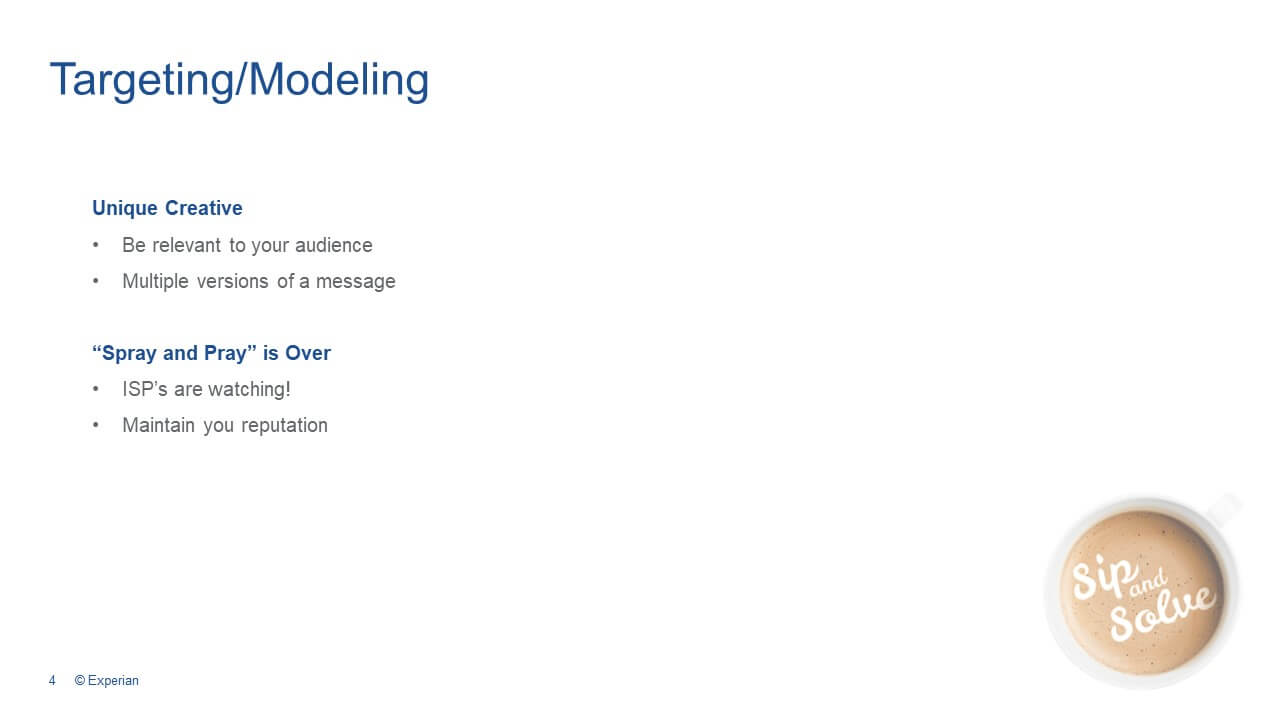
Let's first start with targeting. Now it's very important in order to maximize your ROI, to define your audience as tight and as effectively as possible. A good place to start is to define well, who are your best customers? You might wanna do a look-a-like analysis to see of your existing customer base, how can you use the attributes from them to define a prospect list for the future? Now, it's also important to note that you can get both business level and consumer level data in order to help create these segmentations or models. Now, with the business side, you might want to start with firmographic data, and this could be things like, the company size, you might want to use SIC or NAICS codes to identify what industries they are in; sales volumes, years in business.
That's all very good data for segmentation, but next is also credit related data. And here's what we call BizAggs, it's business aggregate data. These are basically calculations based off of trade level data, which reflects business performance. Some of the main attributes are listed here, but you might want to take a look at bankruptcies or judgements or UCC filings.
That kind of information can actually be used for what we call knockout rules. So if a business is not doing so well, you may not want include them on your email. And then lastly, take a look at credit scores. We have IntelliScore Plus, or IPV, as one score, it basically helps to judge how well do these businesses pay on time.
Another score to look at is the Financial Stability Risk Score, or FSR. And that score basically tells you how financially stable is this company. Will you get paid? Next is consumer level data. And here it's important to think about the C2B Linkage, where now you're associating the person with the business from there.
Now you can get titles, you might want to target the type of decision makers that you think make sense. You might also want to use demographics, personal email; here, where do they do their activity in social media? All of that can be very important to be able to reach the right individual at the right time.
And, you know, if you need help with all this, Experian has analysts to help you develop these type of custom models to segment appropriately. So we're here to help.
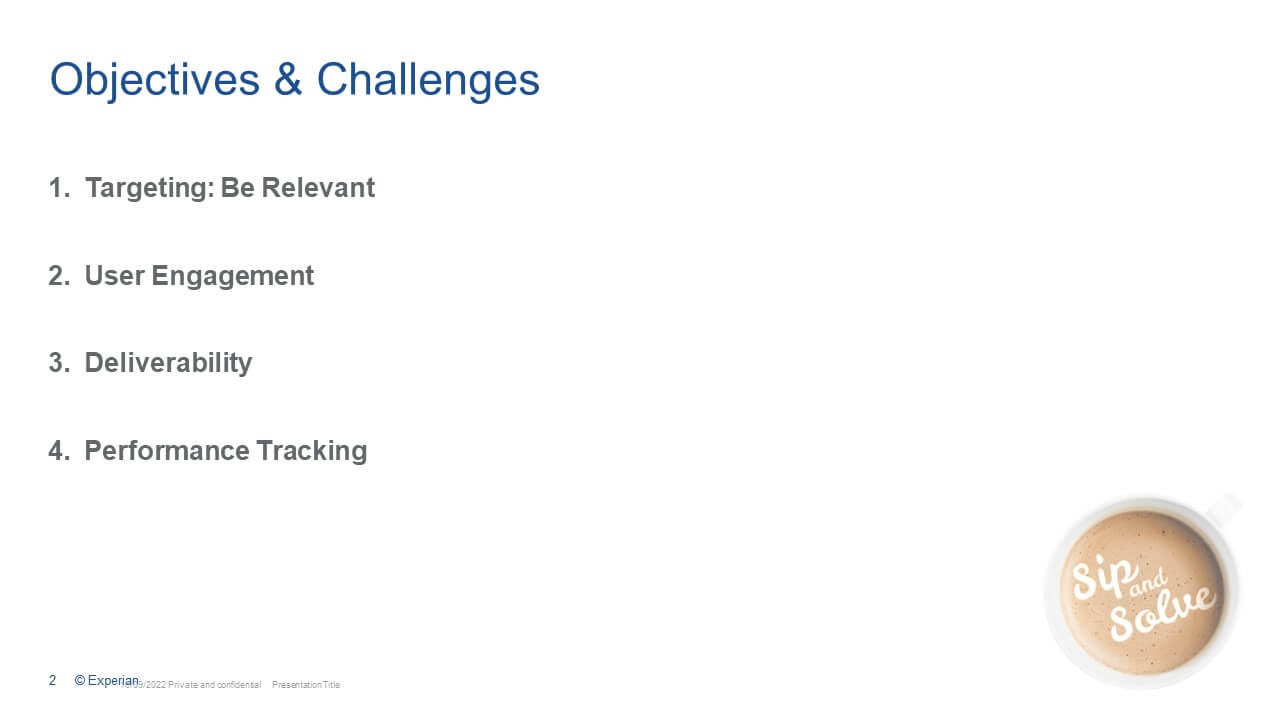
Now the other part to targeting and modeling is then now that you've got your audience defined, now let's define what's the creative that's going to be truly relevant to your audience. And here too, it's very important to make sure that your message is really hitting home to that audience. You might also want to think about testing, like an AB multi variant testing, where you try out different subject headings to different groups of people and see what's landing, as far as relevancy or what's not.
You know, it's important to note that that the "spray and pray" concept of emails is pretty much over. ISP's are becoming increasingly choosy over which messages actually land in the user's inbox and what does not. So it's very important to be relevant, not have emails that are untargeted, going out to a mass audience. That may cause opt outs or complaints, or could cause deletes, and that's gonna have a negative impact on your reputation and that's gonna affect you being possibly put into a spam folder. So it's very key to make sure your targeting is hitting its mark.
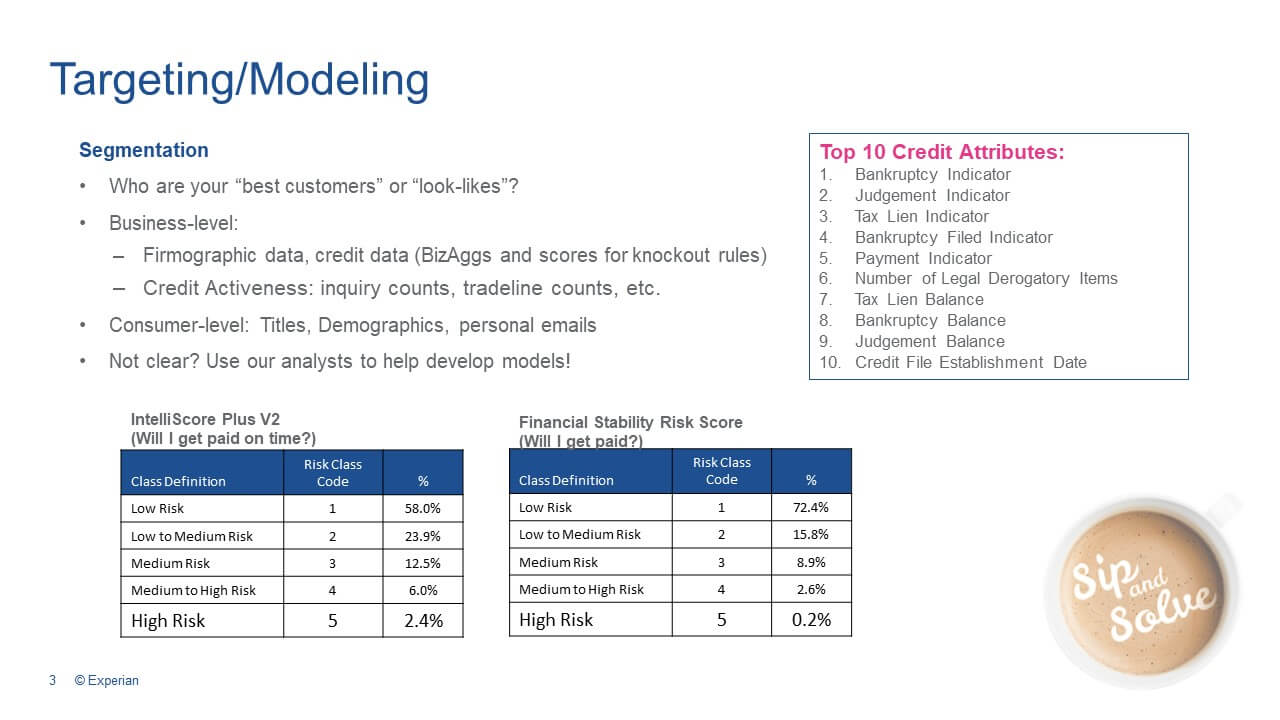
User engagement. Now this has actually become one of the key factors when ISPs are taking a look at how well the reputation of that marketer's message is coming through, and making sure that it gets to the inbox of that user. The more people that are engaged with an advertiser, the more that email truly will get delivered to the inbox and that the ISP will call out that this is a high reputation and then the reverse is true.
So it's very important to get that right. Now it's important to have a strong call to action in your email subject line, the call to action should be enticing enough to call the reader to open the message and learn more about what message you're promoting, and also use a sense of urgency to get them to open it as soon as they see it.
You might also want to implement social marketing, promote integration into platforms such as Facebook, Twitter, LinkedIn, Pinterest, and that'll definitely help to increase the response rate. And this also empowers the user to see, to choose what they wanna see in the future.
Cross channel marketing, definitely think about utilizing social channels and digital display to not just use email, but other types of cross channel tools that you have available to you to get the most impressions to your target audience. And lastly, think about implementing sharing functions.
And this is basically so that users can share the information with colleagues or other people that they think this might have value for. And that'll truly maximize revenue and ROI.
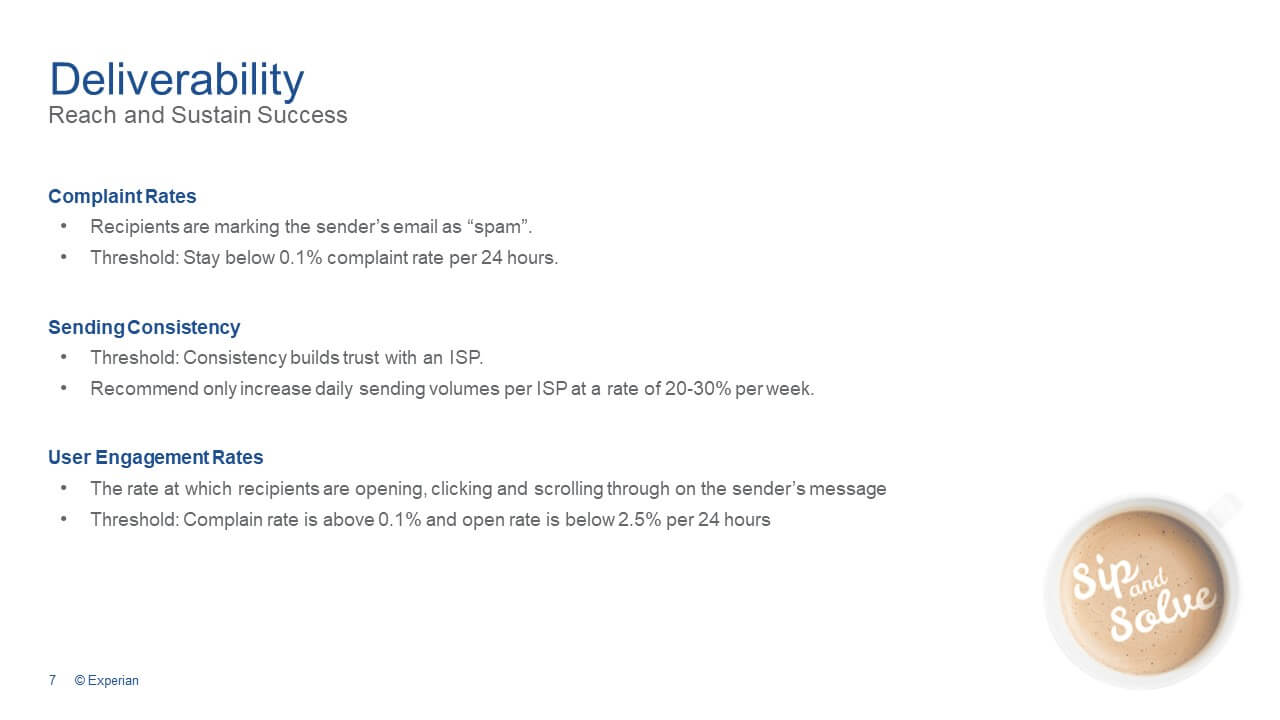
Now, when we think about email deliverability, there's basically two types of classes here. There's deliverable emails, and simply put it's that these emails are actually getting to the inbox of the target audience. And then the non-deliverable emails. Now, deliverable emails have the value that they'll get to the inbox.
And it's great for acquisitions and retention campaigns. But it's also important to note that non-deliverable emails are also important. You can use those for digital onboarding for analytics, for matching. So there's still an important piece of data to consider when you're putting together your campaigns.
Now, what makes that email deliverable? Well it's first of all, that it's a legitimate email address. It's not on the DMA. Do not email list. And that you have strong reputation so that the risk level is low; non-deliverable emails in contrast, are emails that are not validated, not opted in over the last 12 to 24 months.
They could be on the do not email list and these emails could be confirmed to be undeliverable or through because of a high reputation risk, or because it's been suppressed.
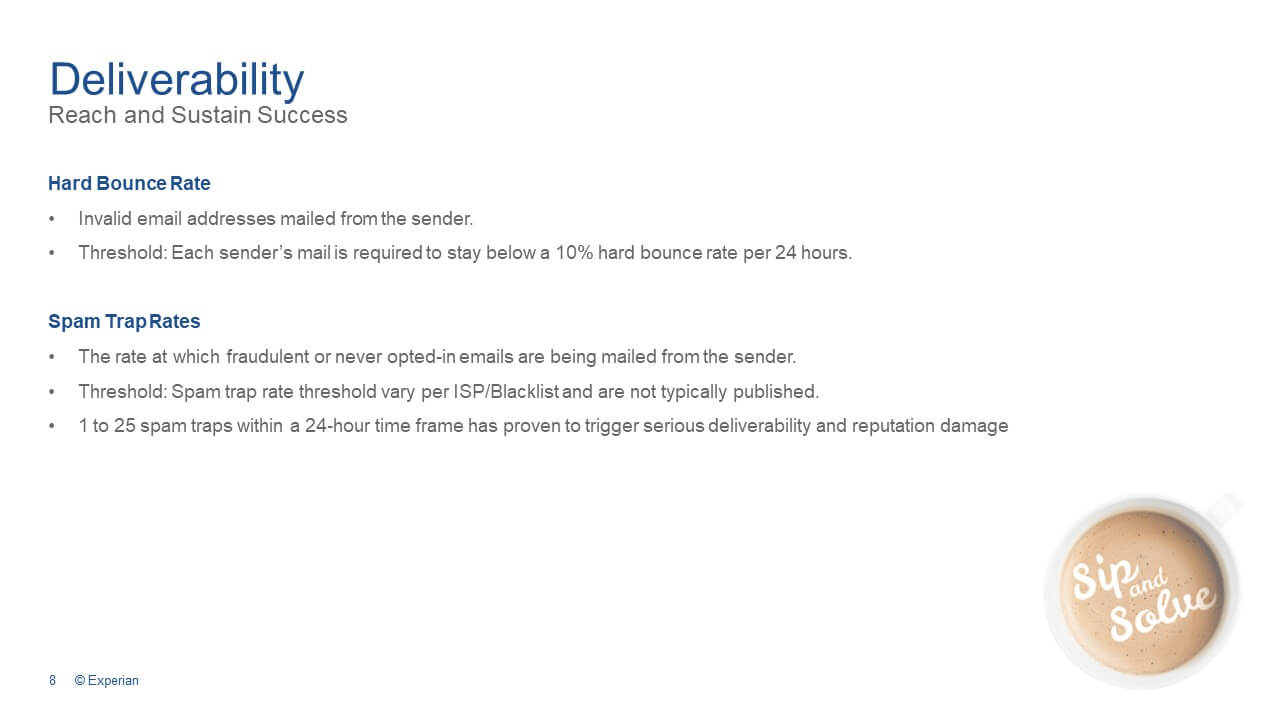
So the most crucial process to reach deliverability success is within the first 30 to 60 days from the time the sender sends these emails out, what the ISP is going to do is they're going to put a probation around these emails in the first 30 days. And they're going to be closely monitoring it with several different types of Analytic metrics.
So in addition to this ramp up process, all centers are required to comply with a specific set of thresholds that the ISP set up and the metrics that the ISP measures determine the inbox placement. The first one to think about is the complaint rates. So this is the amount of times that the recipient marks the sender's email as spam.
And the metric here is that, each center's mail is required to stay below 0.1% compliance in 24 hours. So that's basically one in every 1000 messages.
Sending consistency. How consistent is the email volume and frequencies going out from the sender, and an area to think about is that the recommendation is to only increase the daily sending volumes per ISP at a rate of about 20 to 30% a week.
And lastly is the engagement rates. And this is the rate at which the recipients are opening, clicking and scrolling through the sender's message. and anytime that a center's complaint rate is above 0.1% and the open rate is below 2.5% in a 24 hour per period, this could have reputation risks.
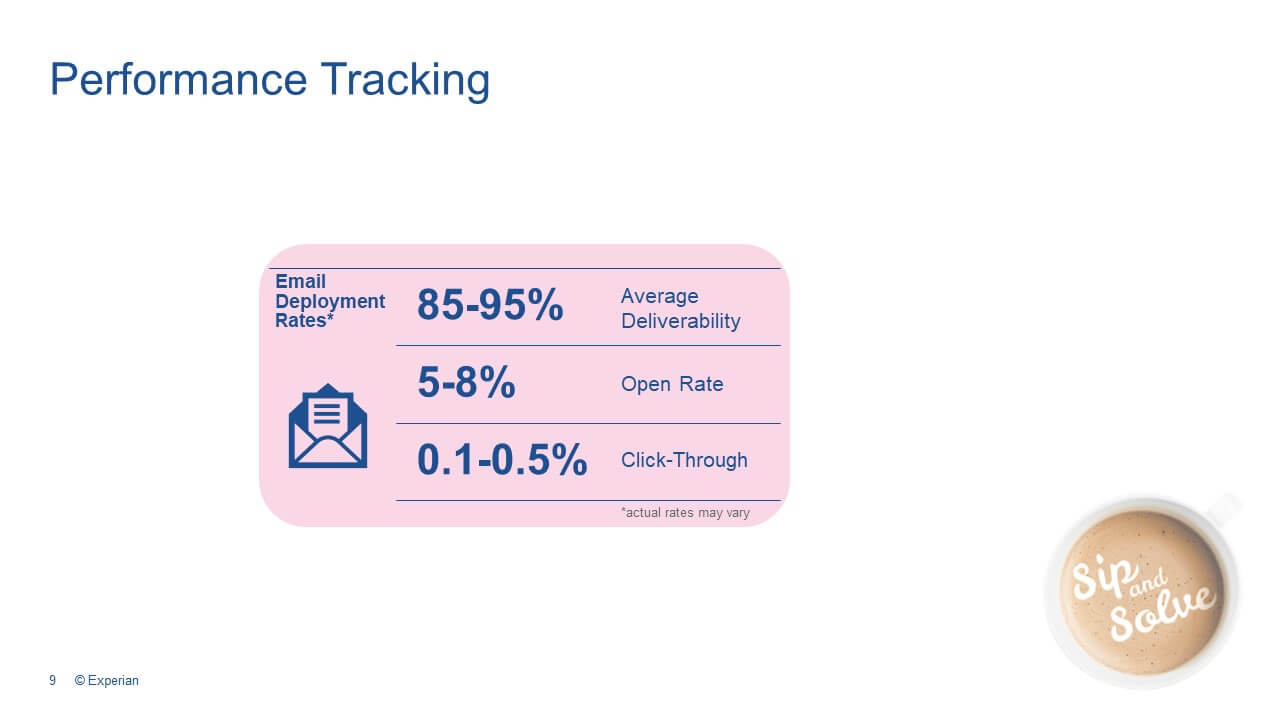
Some other metrics to think about with deliverability are hard bounce rate and spam trap rates.
So hard bounce rate is basically pretty straightforward. It's basically, is the email getting into the inbox. Invalid email addresses won't get there. So what's the threshold. Each sender's mail is required to stay below a 10% hard bounce rate within 24 hours. So that's basically one in every 10 messages, anytime that a sender breaches, that bounce rate, the is ISP will trigger that.
And again, it could trigger a negative reputation.
Spam trap rates. This is the rate at which fraudulent or never opted in emails are being mailed from the sender. Here, the threshold is a little bit tricky. Each ISP has their own definition, but basically a good recommendation is that anywhere from one to 25 spam traps within a 24 hour timeframe could trigger a bad reputation risk from the ISP.

So now let's take a look at performance tracking analytics. When somebody typically thinks of an email campaign, there's three main key performance indicators that are usually thought of. But there's certainly a lot more, but let me start with the top three. First one is the deliverability and anywhere between 85 to 95% is average.
Anything above that is considered really good. In this case, the open rates are typically between five and 8% and the clickthrough rates are between 0.1 to 0.5%.
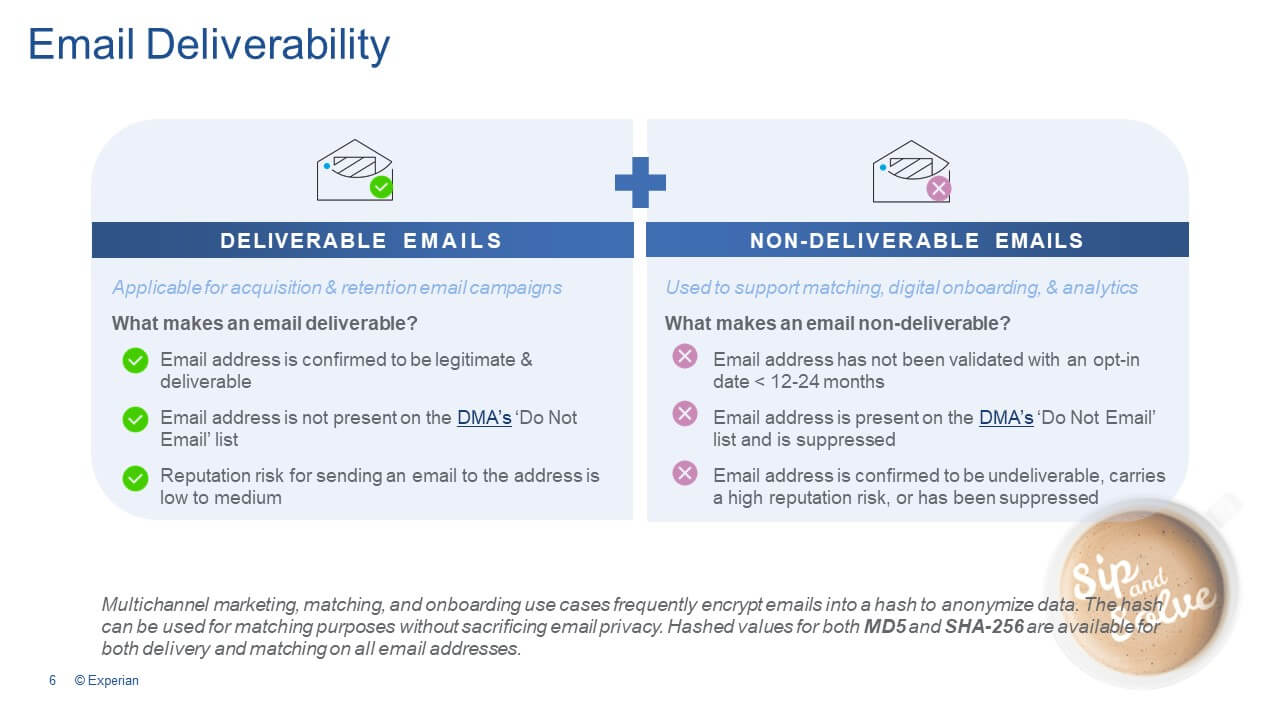
Now, when we think about performance tracking, there's other things to consider here as well. Don't discount branding. You know, if somebody just takes a look at the subject header and gains insight or gains some sort of brand recognition through seeing that email subject header, that could be important.
Multiple call to action mechanisms. So don't forget to provide a phone number or some other ways in which a customer can reach out. And when they do, you want to make sure that your call center is tracking these calls. And then also track the sales conversions. Ultimately, that's your goal, right? Is you're trying to get a sale made.
So it's so important to make sure that you're tracking what your ultimate goal is, whether that's they filled out an application or they they've closed the sale. Those are the kind of ultimate metrics to be capturing.
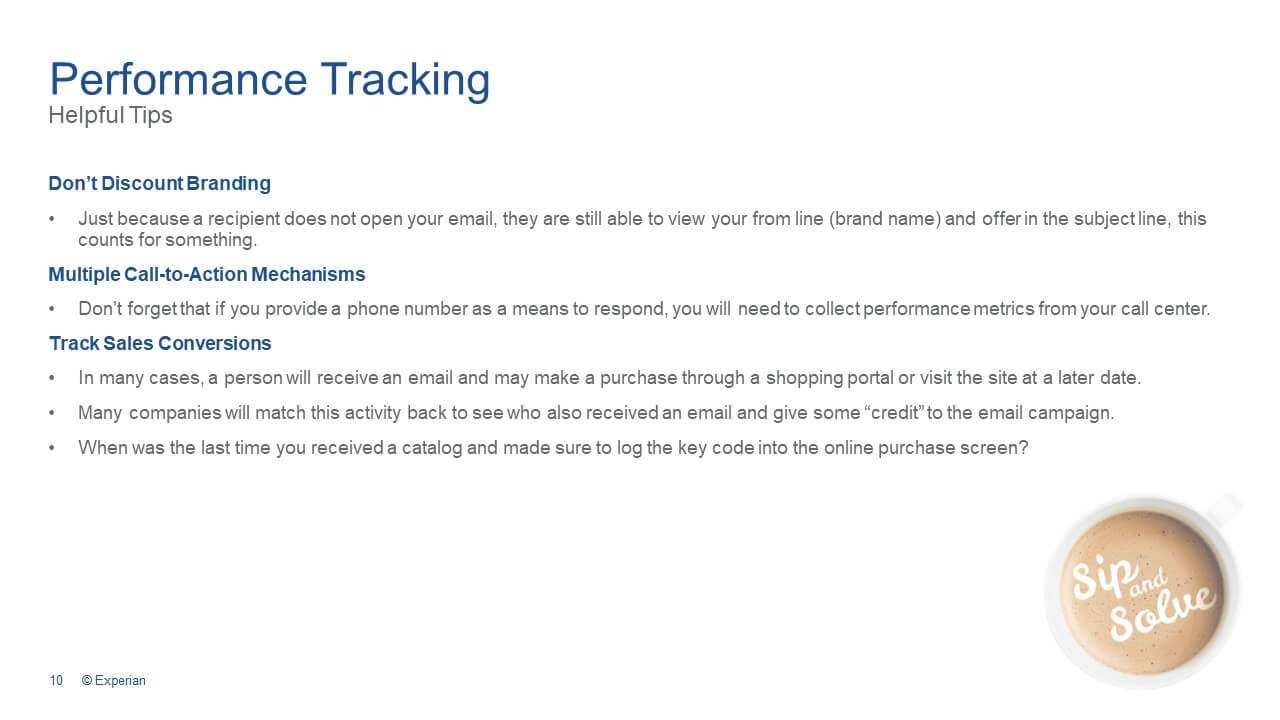
Now let's take a look at some of the performance tracking in much more detail and a typical email campaign metrics report includes the following. So you're first starting out with how many emails were actually ordered, and this could be from an existing customer list, or it could be from an email prospect list, and in this case, we're starting with 13,695 emails total. Now not all of them are going to be sent. There could be reasons for that. And it could be that maybe there was some corrupted information about the emails. So maybe now you're reducing that number of emails to some extent.
Next the deliverability. Again, I've mentioned that. 85 to 95% is a good target to reach, anything 95% or higher is considered best of class. Now on the opposite side, you're gonna have then the number of bounced emails. That's also an important metric to watch out for, to see how many or you're saying bounce and that information can again be used for analytics. And then from there you can measure your deliverability rate.
Next is total opens. So once it's actually in the inbox, how many people actually click to open that email? And that's gonna be a relatively smaller number, right? Um, From there. You also want to measure the unique opens. So this is basically saying that of the number of emails that were opened, how many were not opened twice, for example, or how many were not opened three times. And that's important to make sure that you're really getting down to reachability to your audience.
Next is the open rate and that's one to track as well. The unique open rate, in addition to that, next is total clicks. So total clicks is basically once they've opened the email, there should be a call to action in your email. How many people have actually clicked on that call to action. And from there you can get your click through rate. You can also get your unique click through to open rate. The next is to think about unsubscribes because that's the other call to action within an email, is the capability for the user to unsubscribe. Definitely make sure you're capturing that.
Next is landing page. So after a user has actually clicked on a call to action, are they truly getting to the landing page where you want them to go? And there, it's important to think about having a tracking pixel to fire up so you can capture that data.
And then lastly was your goal met. And again, I've mentioned several goals, whether it was filling out an application or filling out a form with the contact information or was a sales made against this. Those are all the different type of goals that you want to make sure you're capturing.
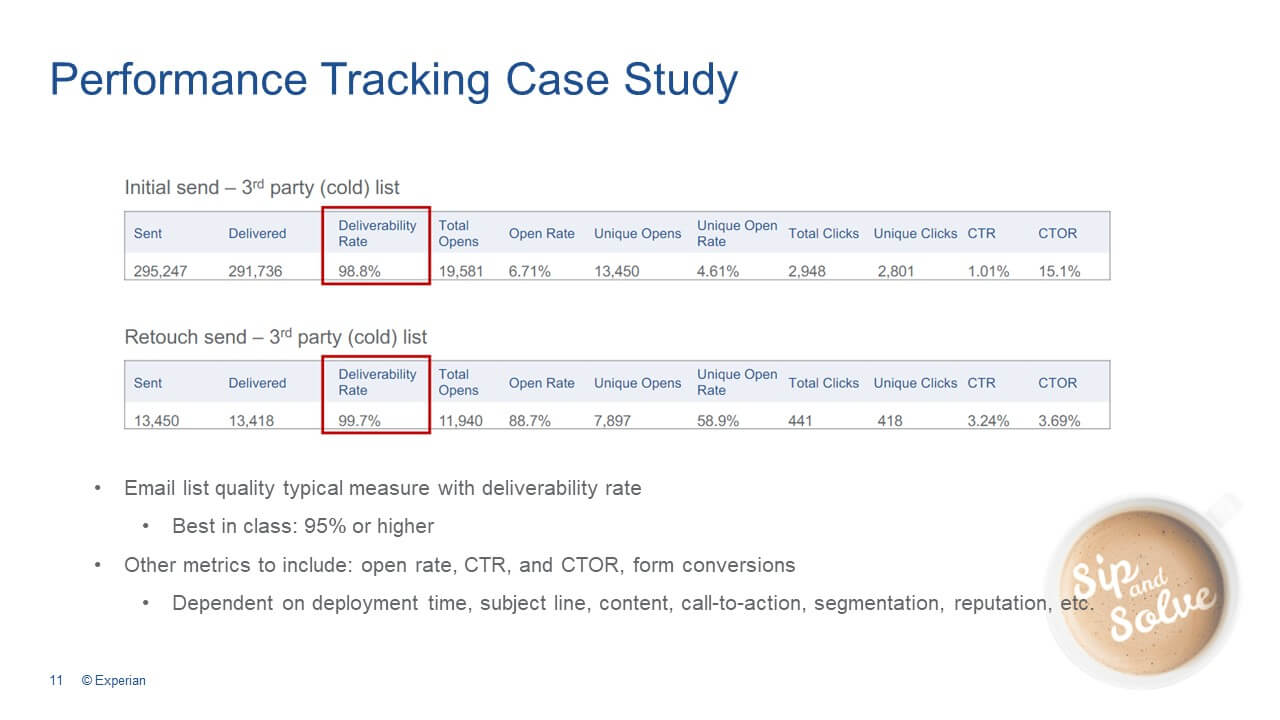
Now recently Apple has introduced some privacy protection policies that definitely affect email campaigns. And the primary one to consider is the mail privacy protection. Basically what that is, is Apple wants to protect their users for what emails they're actually receiving to make sure that they're legitimate.
So they have set up a proxy server to basically open emails first and cache them prior to the user being able to receive those emails. What this causes is open rates to increase dramatically since the proxy server is opening up all of the emails. And so that KPI is no longer reliable since you have an artificially high open rate.
This also causes your click to open rates to be artificially low because of the open rates being high. So that is also a going to be an unreliable KPI to work with. So what KPIs here in the future should you rely on? Definitely deliverability, as I had mentioned earlier, is going to be very key.
And then the next ones are engagements. Did the users click on the call to actions? Did they opt in? Did they convert? Did they actually meet the goals that you were trying to do? And placing tracking pixels along those different engagement events is gonna be very important.
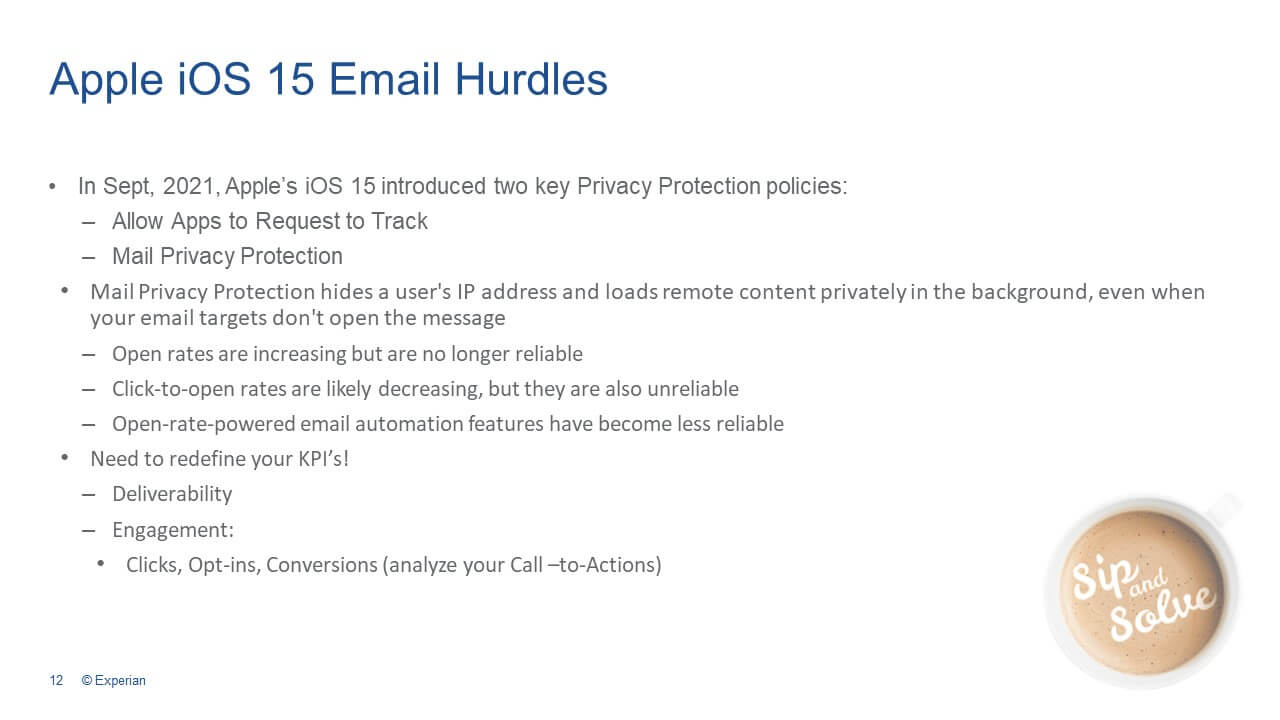
So in summary, focus, focus, focus. Again, I can't stress enough how your ROI is going to be greatly impacted by defining your audience. And making sure that your messaging is truly being relevant is truly relevant to your audience.
And then make sure that your email list is clean and current. Using current data lists as well as going through email hygiene. And then measure the success through these different KPIs that I had mentioned throughout this presentation.
And we can help you to review your KPIs and see where lessons learned, what went well, what didn't and how to improve in the future.
Well, that's all I have for you today. Thanks for spending your coffee break with me. Hopefully I was able to help you to understand email campaigns, the KPIs, and the analytics around email campaigns.
If you would like to gain some additional insights, why not go to our private group on Facebook? You can engage with our experts, access exclusive content and chat with peers. Just scan the QR code shown here. Also, if you want to get notified of future sessions, make sure to join the list.
Now let's get back to work.
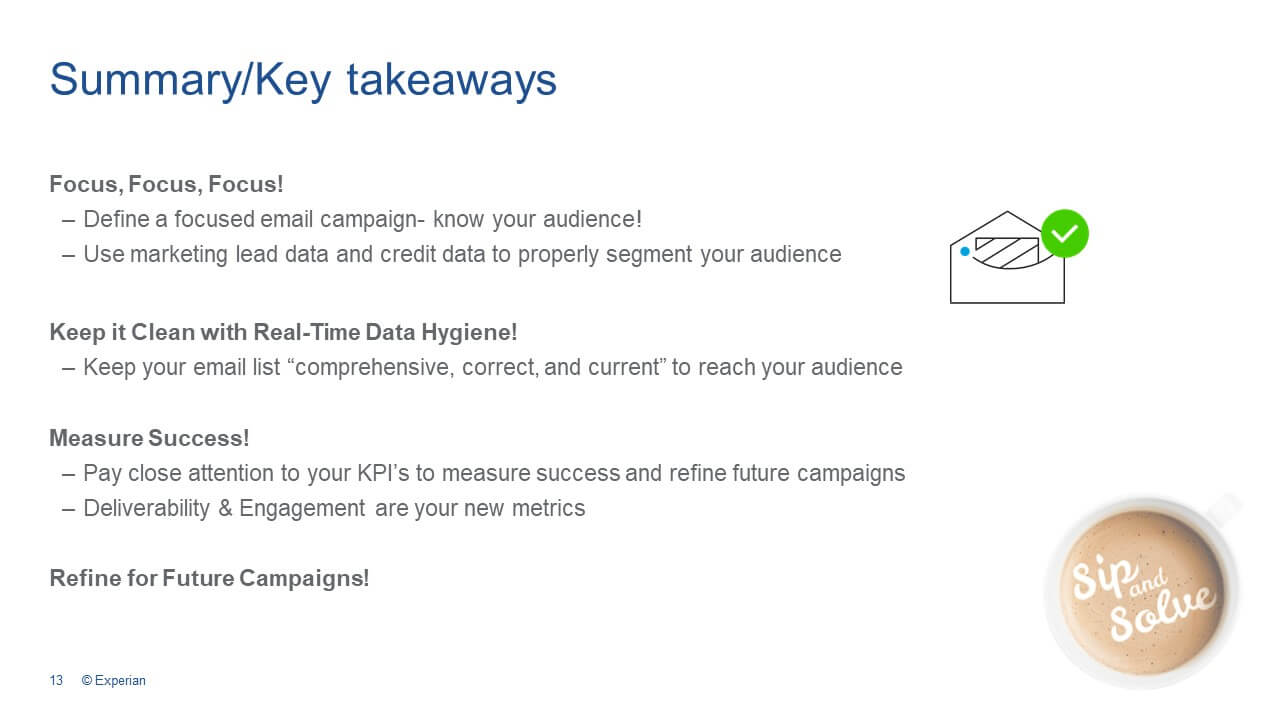
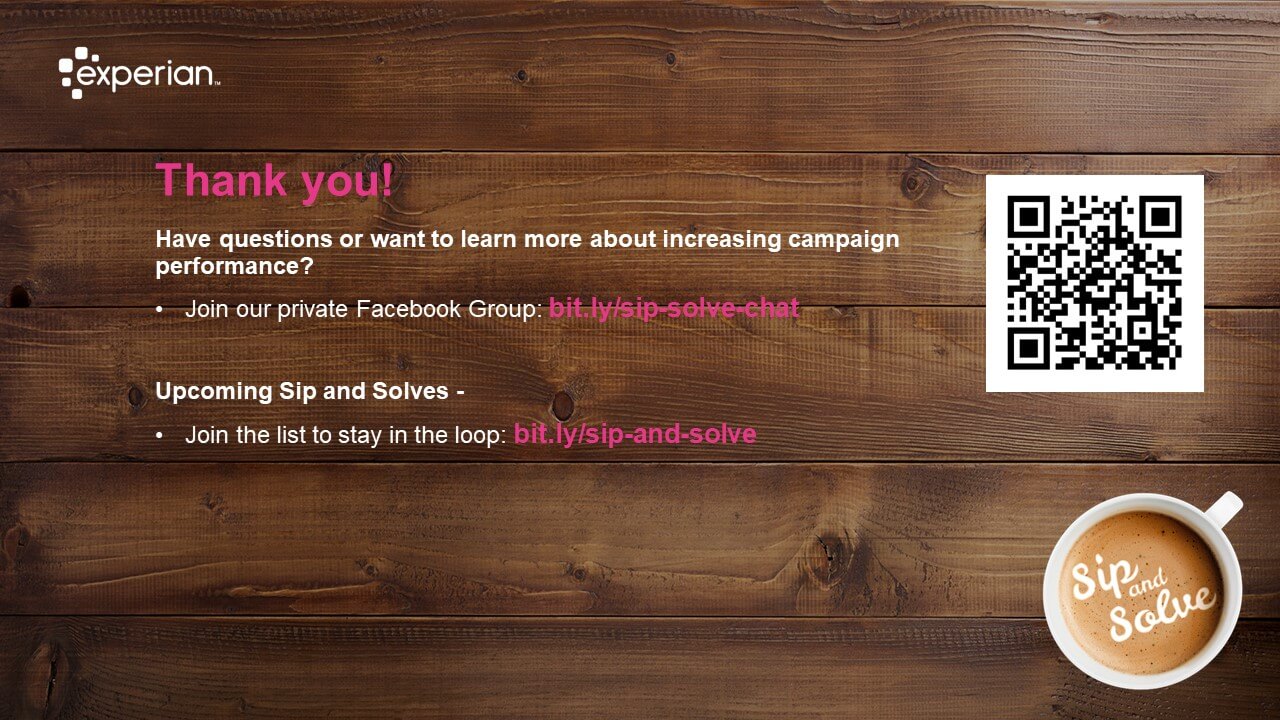

Tony recently joined the Experian BIS team as a Senior Product Manager. He has experience in product lifecycle management, product ideation and strategy, business development, forecasting, performance management and data-driven decision-making, and more.
Tony says, "As a Product manager, it is critical to properly define the criteria to success and key performance indicators. Defining these metrics, collecting and analyzing the data, and testing out options provides the level of preparation, and data-driven decision-making required by a Product Manager to lead with confidence for new initiatives, develop roadmaps and drive it to success."